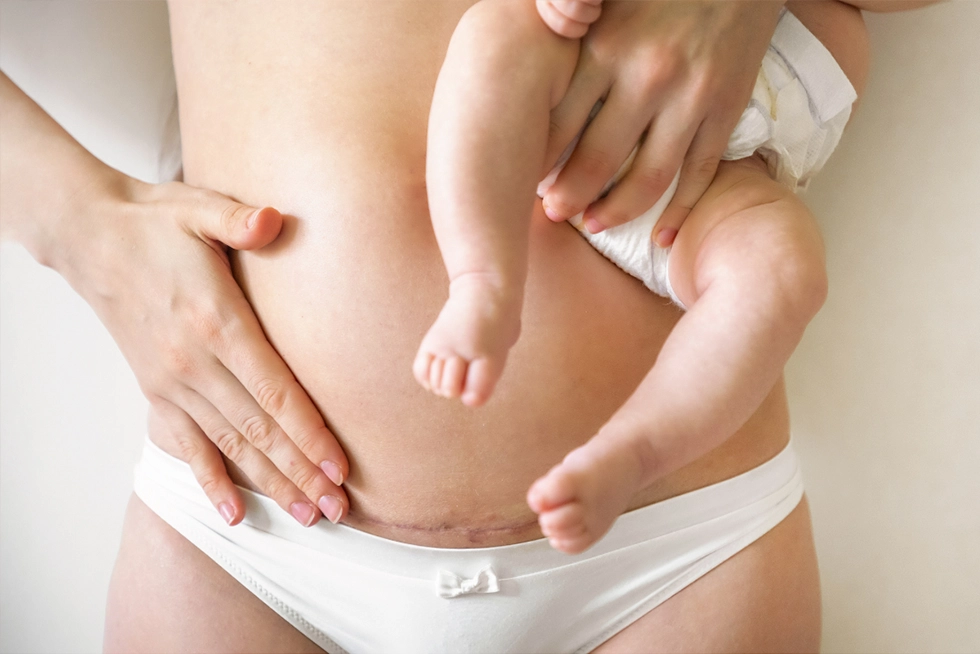Updated April 2025: Current stats, expert insights, and real-mom FAQs to help you feel confident and supported.
If you’re here, there’s a good chance a cesarean birth is part of your story—or might be. Maybe your doctor just brought it up. Maybe it’s already on the calendar. Or maybe you’re still trying to make sense of an unexpected surgical delivery. However you got here, we want you to know: you’re not alone.
About 1 in 3 births in the U.S. are cesarean deliveries (CDC, 2023).
That number alone tells us just how many women are walking this path—whether it was planned, unplanned, or somewhere in between. Whether you’re feeling strong, uncertain, frustrated, grateful, or all of the above… we see you. And this guide is here to help you feel more informed, supported, and empowered—however your birth unfolds.
If your goal was a vaginal delivery, hearing your OB mention a potential C-section can be an emotional curveball. There’s a lot to learn about why they happen, how they’re performed, and what it means for your postpartum recovery.
And because April is Cesarean Awareness Month, we’ve teamed up with one of New Mom School’s trusted advisory experts—Dr. Jeffrey Illeck, MD—to answer some of the most common medical questions about cesarean birth.
Expert Q&A with Dr. Jeffrey Illeck, MD
Why would someone need a cesarean?
The most common reason for a first-time mom to need a cesarean is due to arrest disorders—either not reaching 10 cm dilation (arrest of dilation) or not being able to push the baby out (arrest of descent). The second most common reason is abnormal fetal heart rate or fetal intolerance to labor.
What makes a cesarean an “emergency”?
Emergent cesareans are usually triggered by fetal distress or concerning heart rate patterns. In these cases, the goal is to deliver the baby as quickly as possible—ideally within 30 minutes, per ACOG guidelines. In true emergencies, delivery can happen in under a minute once anesthesia is ready.
Can I have skin-to-skin contact after a C-section?
Yes. Many hospitals—including Hoag—prioritize immediate skin-to-skin contact after cesarean birth, based on the parent’s preferences. After a quick newborn assessment, the baby is brought directly to the parent whenever possible.
Can I have a vaginal birth after a cesarean (VBAC)?
Absolutely, for many women. Most people with a low transverse uterine incision are candidates for VBAC, as long as the hospital is equipped for it. Factors like baby’s size, spontaneous labor, and cervical readiness all play a role in your likelihood of success.
A healthy baby and a safe delivery are always the top priority. A cesarean doesn’t mean you failed—it means you did what was best in the moment.
What are the biggest misconceptions about C-sections?
Because they’re common, cesareans are often viewed as “no big deal”—but they’re still major abdominal surgeries. Risks can include infection, bleeding, injury to internal organs, and complications in future pregnancies. Still, cesareans can be life-saving and are sometimes the safest option for mom and baby.
Any advice for recovering from a cesarean?
Be gentle with yourself. Your body just went through surgery, and recovery takes time. Don’t hesitate to ask for help. Use your pain meds if needed, take stool softeners, hydrate, and eat iron-rich foods. Rest as much as possible and listen to your body. You’re healing and learning to care for your baby at the same time—and that’s a lot.
Top Google-Searched C-Section FAQs
(And What You Should Know)
While Dr. Illeck addressed the medical and emotional side of cesarean birth, we know there are lots of everyday questions moms are searching for—especially in those quiet, late-night scrolls.
Here are some of the most common questions about C-section recovery, answered simply and clearly:
How long does C-section recovery take?
Most people feel more like themselves around 6 to 8 weeks, but full internal healing can take longer.
When can I drive after a C-section?
Usually after 2 weeks, as long as you’re not taking narcotics and can move comfortably. Always check with your provider.
What does a C-section scar look like?
Most are low, horizontal incisions that fade over time. Scar massage, silicone sheets, and time help with healing.
Is C-section more painful than vaginal birth?
It depends. C-section recovery is often longer, but vaginal births may have more short-term discomfort. Everyone’s pain experience is different.
Can I breastfeed after a cesarean?
Yes! You might need to try different nursing positions (side-lying is a favorite), but breastfeeding is absolutely possible after surgery.
Helpful Extras to Support Your C-Section Recovery
We know that healing isn’t just physical—it’s mental, emotional, and logistical too. That’s why we’ve created a few simple tools to help you navigate your recovery with a little more comfort and clarity:
Recovery Essentials: Handpicked Just for You
Check out our favorite mom-tested Amazon finds to help make your postpartum healing a smoother process!
From belly bands that support your core to scar care must-haves, gentle mobility aids, and other practical comfort items, this curated list is here to help you feel held—literally and figuratively.
👉 Shop our C-section recovery picks
Download the Recovery Checklist
A printable, fridge-friendly list of post-op care tips to help guide your healing—from movement and rest to hydration and emotional support.
👉 Get the checklist
You Deserve to Feel Supported
Cesarean birth isn’t always what you plan for—but it is birth. It’s strong. It’s valid. And it deserves respect and support.
Whether your birth was scheduled, emergency, or somewhere in between, you deserve to feel informed, cared for, and confident as you recover.
For more insights on postpartum care, VBAC stories, and expert-backed resources, visit the New Mom School Blog.
Want support that actually gets it?
Find your local New Mom School and connect with a community of moms, experts, and real talk that makes the fourth trimester feel a little less overwhelming.
Wishing there was a New Mom School closer to you?
You might be the one to bring it there. Learn how to open a location in your town.

